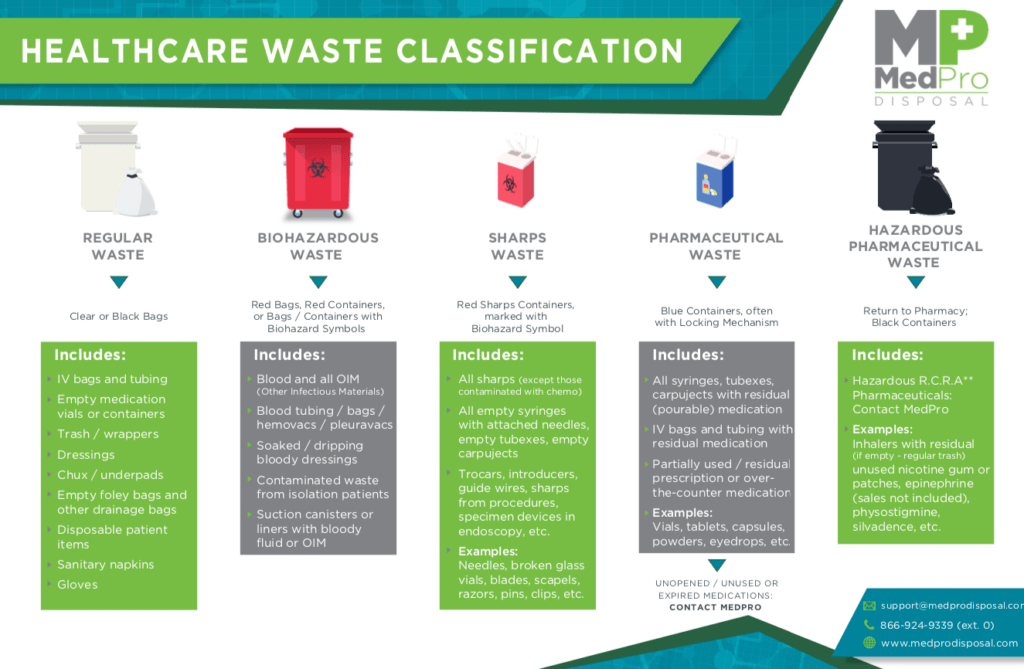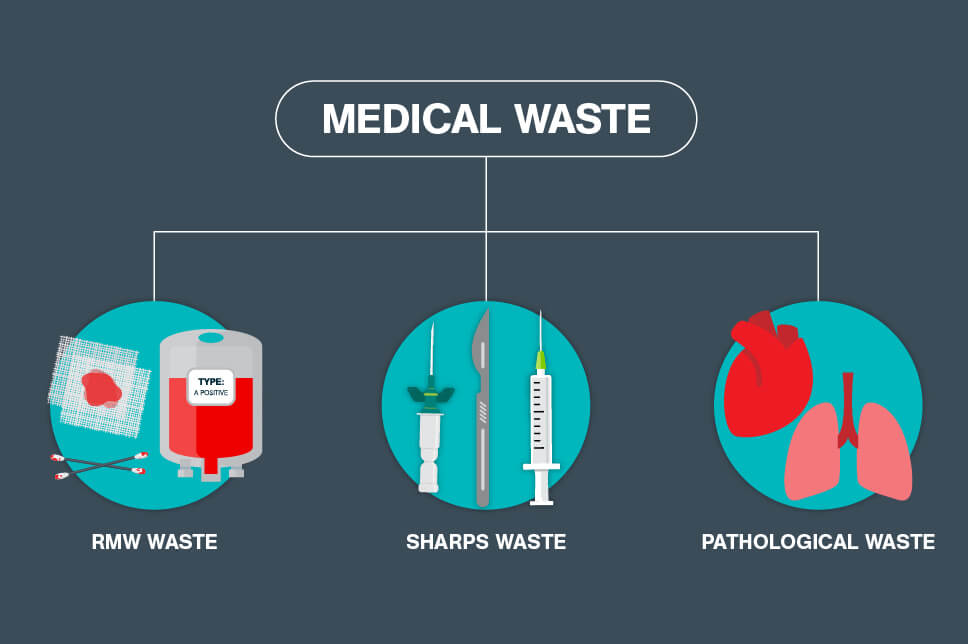Finest Practices for Medical Waste Monitoring
Medical waste monitoring is a critical aspect of healthcare facilities' operations to ensure the safety of individuals, staff, and the environment. Carrying out best practices in medical waste management is vital to decrease the threats associated with dangerous waste.

Partition and Classification
In the field of clinical waste management, proper segregation and classification are important methods for guaranteeing the secure and reliable disposal of healthcare-related products. Clinical waste is generated from various resources, including hospitals, facilities, laboratories, and other healthcare facilities. It consists of a vast range of things, such as needles, syringes, plasters, handwear covers, and pharmaceutical waste.
Partition involves the systematic separation of various kinds of clinical waste based upon their characteristics and possible risks. This procedure helps to stop cross-contamination and guarantees that each kind of waste is managed appropriately. For example, sharps waste, such as needles and blades, should be positioned in puncture-resistant containers to avoid injuries and the spread of transmittable illness. In a similar way, infectious waste, such as blood-soaked bandages or societies, ought to be set apart and treated independently to minimize the danger of spreading out microorganisms.
Categorization is the process of categorizing medical waste into different classifications based on its potential risks. These groups might consist of contagious waste, hazardous waste, pharmaceutical waste, and general waste. By classifying waste, medical care centers can determine the ideal disposal approaches and guarantee compliance with neighborhood laws and guidelines.
Correct partition and classification of clinical waste not only protect the health and wellness of healthcare workers and the public however likewise add to the overall effectiveness and efficiency of waste management. It reduces the danger of crashes, reduces environmental impacts, and promotes liable waste disposal practices.
Appropriate Storage and Identifying
To ensure the safe and effective disposal of medical waste, health care facilities must comply with appropriate storage space and labeling techniques. WasteX Medical Waste Disposal. Proper storage space and labeling play an important function in keeping the integrity of medical waste administration systems and securing the wellness and safety and security of healthcare employees, clients, and the public
When it involves storage space, it is vital to have actually marked areas particularly designed for various kinds of clinical waste. These locations must be safe and secure, well-ventilated, and furnished with suitable containers that satisfy regulative standards (medical waste disposal service). Segregation and classification of waste ought to also be taken into account to avoid cross-contamination and prospective threats

Regular monitoring and evaluation of storage space areas and containers are important to identify any type of issues or infractions. Personnel needs to be educated on proper storage space and labeling practices, highlighting the relevance of conformity with laws and protocols.
Safe Transport and Handling
Making certain the safe and secure and proper transport and handling of medical waste is crucial for preserving the honesty of waste administration systems and securing the health and wellness and safety of all included. Clinical waste, that includes products infected with transmittable materials, pharmaceuticals, and various other hazardous materials, should be transferred in a fashion that stops leaks, spills, and potential contamination.
It is important to use puncture-resistant and leak-proof containers that are specifically designed for clinical waste. Furthermore, waste needs to be set apart based on its nature and kind to prevent cross-contamination.
During transport, it is necessary to make certain that waste containers are firmly attached and saved in a stable fashion. Vehicles made use of for carrying clinical waste must be furnished with proper safety and security features, such as spill containment systems, to decrease the risk of any spills or leaks. Motorists need to get training on appropriate handling and emergency situation feedback procedures to successfully resolve any unpredicted occurrences.
Furthermore, the transportation and handling of medical waste need to abide by all appropriate guidelines and guidelines stated by neighborhood, state, and government authorities. WasteX Medical Waste Disposal. medical waste removal. Regular examinations and audits need to be performed to evaluate conformity and identify any areas for enhancement
Compliance With Regulatory Standards
Preserving conformity with regulative standards is vital for reliable medical waste monitoring. These guidelines are put in place to secure public health and the setting by guaranteeing that clinical waste is properly taken care of, dealt with, and disposed of. Compliance with regulative standards aids to prevent the spread of contagious conditions, decrease possible dangers, and reduce the total impact of medical waste on the environment.
To achieve compliance, medical care facilities should remain informed regarding the particular guidelines governing clinical waste administration in their territory. These policies may vary from nation to nation, and also within various states or areas. It is important for healthcare facilities to have a detailed understanding of these guidelines and to carry out appropriate strategies and methods to make sure conformity.
One trick aspect of compliance is the proper partition and labeling of different kinds of clinical waste. This consists of dividing sharps from various other waste, as well as classifying waste based on its possible dangers. Health care centers should also make sure that clinical waste is stored in ideal containers and that these containers are properly identified and secured.
Moreover, compliance with regulative standards needs health care facilities to develop proper training and education programs for personnel associated with clinical waste management. This includes supplying training on waste partition, dealing with, and disposal procedures, along with the correct usage of individual safety equipment.
Routine tracking and audits are additionally necessary to make sure ongoing conformity with governing guidelines. This includes performing routine examinations of waste storage space locations, documenting waste management procedures, and maintaining records of waste disposal.
Efficient Disposal Techniques
Healthcare centers need to employ effective disposal techniques for appropriate management of clinical waste. Inappropriate disposal of medical waste can position severe health and ecological dangers. There are a number of approaches that can be utilized to effectively throw away clinical waste, making certain the safety of health care employees, patients, and the basic public.
One commonly made use of technique is incineration. Incinerators can safely shed medical waste at high temperature levels, minimizing the volume and destroying any kind of possibly unsafe pathogens. Nonetheless, incineration can be costly and might launch damaging contaminants right into the air if not correctly controlled.
One more method is autoclaving, which involves subjecting the waste to high-pressure vapor. This procedure eliminates germs, viruses, and various other bacteria, rendering the waste risk-free for disposal in normal waste streams. Autoclaving is a effective and eco-friendly approach, however it requires customized tools and skilled personnel.
Chemical sanitation is also utilized in some instances, where liquid chemicals are put on the waste to sanitize it. This technique is much less commonly utilized as a result of problems concerning the effectiveness of chemical disinfection and the capacity for chemical residues to pollute the setting.
Along with these approaches, healthcare centers ought to likewise apply correct partition, product packaging, and labeling of clinical waste to guarantee its secure handling and disposal. Normal training and education of team on correct waste administration methods are crucial to keeping efficient disposal techniques.
Verdict
To conclude, implementing ideal practices for clinical waste administration is vital for making sure the security of health care workers, people, and the environment. By properly segregating and classifying waste, saving and identifying it properly, guaranteeing safe transport and handling, complying with regulatory standards, and utilizing efficient disposal approaches, health care centers can efficiently take care of and decrease from this source the risks related to clinical waste. It is crucial for health care organizations to adhere and prioritize to these finest techniques to keep a lasting and risk-free medical care environment.
Clinical waste administration is a vital element of healthcare facilities' operations to make sure the safety and security of people, team, and the environment. Executing best techniques in clinical waste management is vital to decrease the risks connected with dangerous waste. These categories may include transmittable waste, unsafe waste, pharmaceutical waste, and basic waste.In verdict, implementing finest techniques for clinical waste management is essential for ensuring the safety and security of medical care workers, individuals, and the setting. By appropriately classifying and setting apart waste, keeping and identifying it correctly, ensuring safe transport and handling, conforming with governing standards, and using efficient disposal methods, medical care facilities can efficiently manage and minimize the threats associated with medical waste.